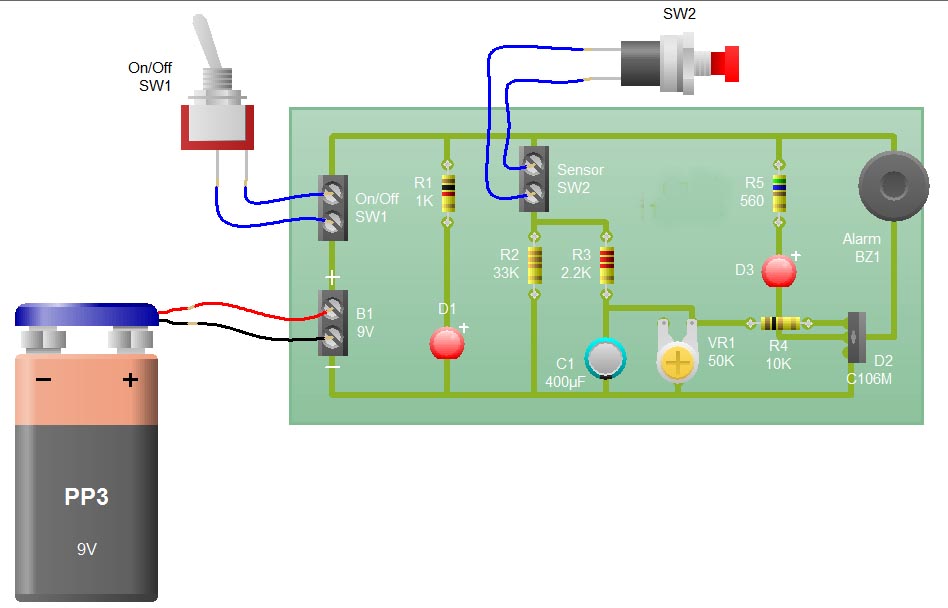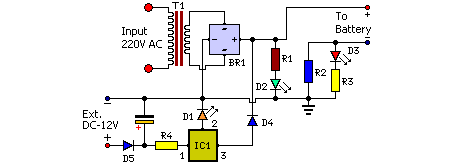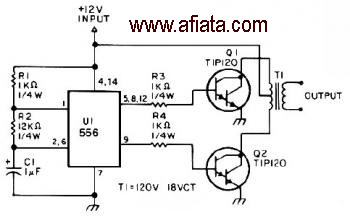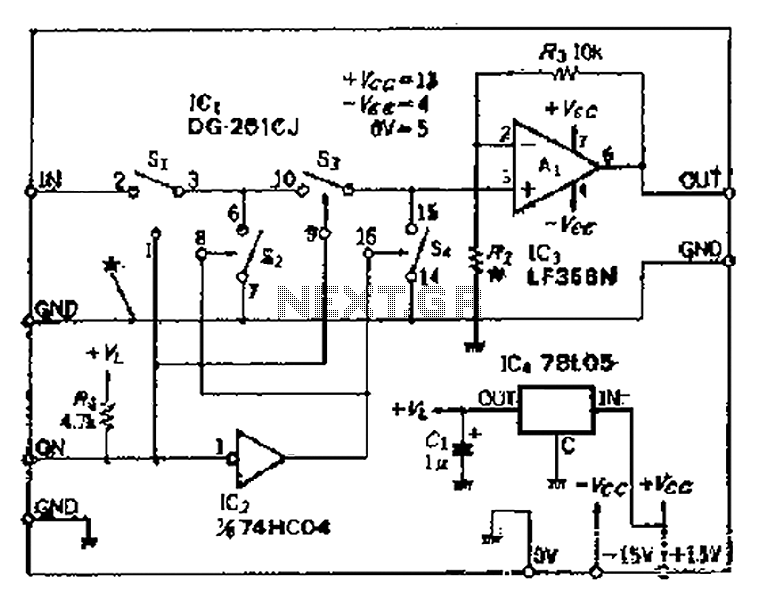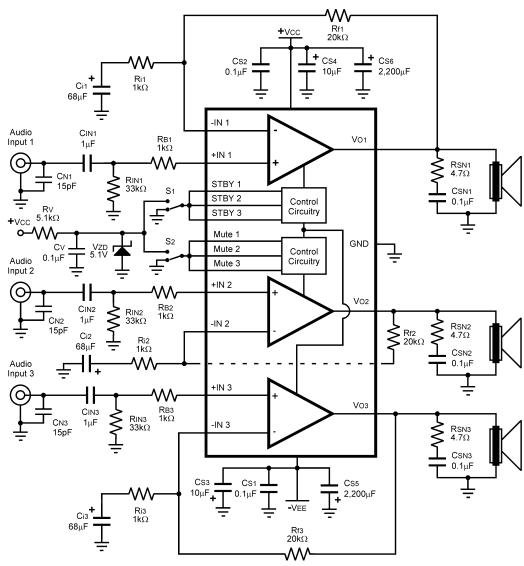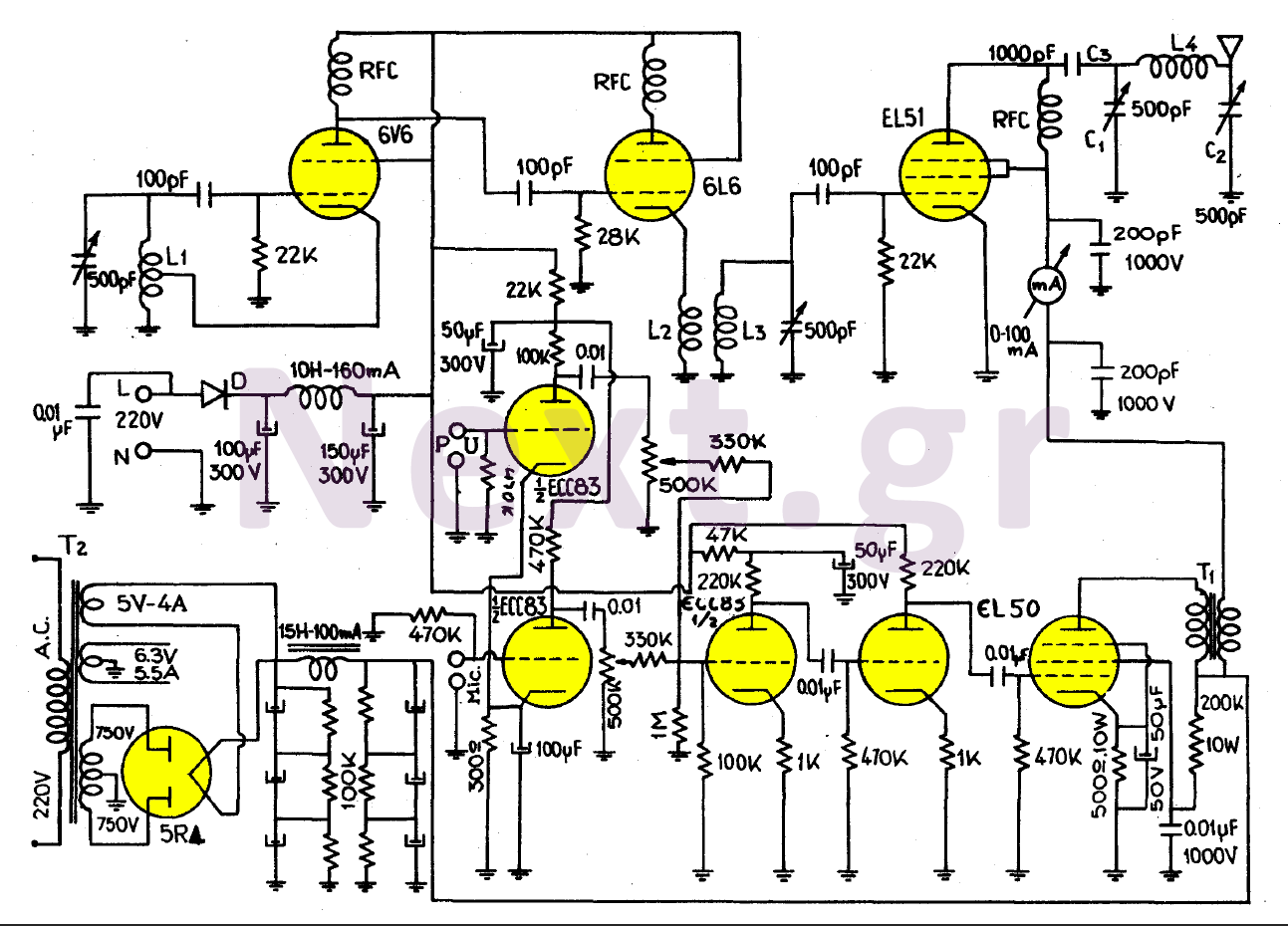
Audio Mixer 6 Channel circuit
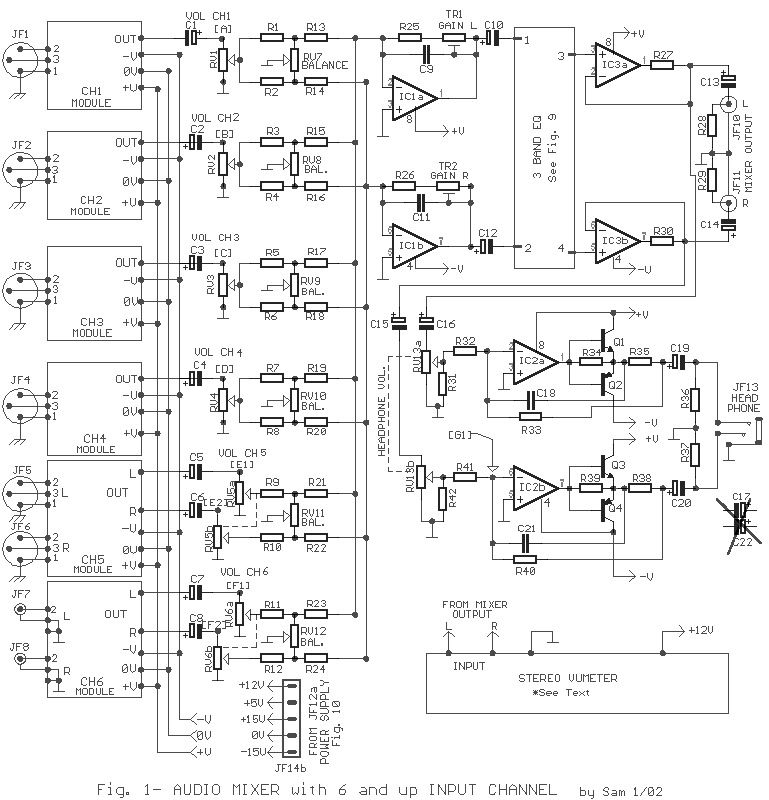
The main circuit of the 6-channel mixer consists of six input channels. Channels 1-4 are mono, while channels 5-6 are designed for music use. The number of input channels can be increased as desired. The output of each channel drives the sound control potentiometers RV1-6. Additionally, RV7-12 creates a balance between the two channels. All signal input channels are summed at this point using two operational amplifiers (IC1A-B), with each channel equipped with two trimmers (TR1-2) to adjust the gain of each IC, allowing for output signal level adaptation. A three-band equalizer is implemented in the next stage using IC3, ensuring essential isolation from previous stages. For headphone users, a classic headphone circuit is built around IC2A-B, providing output to JF13. There are also tracks for optical audio levels, accompanied by a stereo level meter.
The 6-channel mixer circuit is designed to facilitate audio mixing with flexibility and control over multiple input sources. The six input channels allow for a variety of audio signals to be processed simultaneously. Channels 1 through 4 are mono, making them suitable for single audio sources, while channels 5 and 6 can accommodate stereo signals, particularly beneficial for music applications.
The sound control potentiometers (RV1-6) serve to adjust the volume levels for each channel independently, providing the user with the ability to balance audio levels according to their requirements. The additional potentiometers (RV7-12) are critical for maintaining the balance between the left and right audio channels, ensuring a cohesive sound output.
The summing stage, utilizing operational amplifiers IC1A and IC1B, plays a pivotal role in combining the audio signals from the various channels. The inclusion of trimmers (TR1-2) allows for fine-tuning of the gain for each operational amplifier, enabling precise control over the output signal levels. This feature is particularly useful for adapting to different audio sources and ensuring optimal performance.
Following the summing stage, the three-band equalizer (IC3) is implemented to allow the user to adjust the tonal quality of the audio output. This equalizer provides control over low, mid, and high frequencies, allowing for customization of the sound to suit specific preferences or requirements. The design ensures that the equalizer operates with isolation from previous stages, maintaining audio integrity.
For headphone monitoring, the circuit incorporates a dedicated headphone amplifier using IC2A and IC2B. This component provides a headphone output at JF13, allowing users to monitor audio signals directly. The design ensures that the headphone output is clear and provides sufficient volume for effective monitoring.
Additionally, the circuit features tracks for optical audio levels, which can be utilized for visual monitoring of audio signal levels through a stereo level meter. This feature enhances the usability of the mixer, allowing for real-time feedback on audio performance.
Overall, the 6-channel mixer circuit is a versatile and comprehensive solution for audio mixing applications, equipped with essential features for sound control, equalization, and monitoring.The following is a main circuit of the mixer-6 Ch The circuit consists of six input channels. The mono channels are channels 1-4 and 5-6 CH CH, are intended for use by music. The number of input channels you want as she can greatly increase you want. The output of each channel drives the RV1-6, the level of sound control potesometer. With RV7-12 c reate the conditions of equilibrium between the two channels (BALANCE). All signal input channels are added at this point two vipers [IC1A-b] for each channel has two trimmer Here TR1-2 to adjust the gain of each IC, adapting the level of the output signal in the level we want. That can be suppressed if you need something and Standard and Poor. The next stage is a three-band equalizer of regulation. The IC3 ±-b, are off the table, they want an acre to make a profit and they want to do the essential isolation of the previous stages, with the unit that drives us.
For whoever they want to use headphones, there is a classic circuit unit of the headphones around the IC2a-b, which give the output in the JF13. There are also tracks can also optical audio levels, with a stereo level meter. 🔗 External reference
The 6-channel mixer circuit is designed to facilitate audio mixing with flexibility and control over multiple input sources. The six input channels allow for a variety of audio signals to be processed simultaneously. Channels 1 through 4 are mono, making them suitable for single audio sources, while channels 5 and 6 can accommodate stereo signals, particularly beneficial for music applications.
The sound control potentiometers (RV1-6) serve to adjust the volume levels for each channel independently, providing the user with the ability to balance audio levels according to their requirements. The additional potentiometers (RV7-12) are critical for maintaining the balance between the left and right audio channels, ensuring a cohesive sound output.
The summing stage, utilizing operational amplifiers IC1A and IC1B, plays a pivotal role in combining the audio signals from the various channels. The inclusion of trimmers (TR1-2) allows for fine-tuning of the gain for each operational amplifier, enabling precise control over the output signal levels. This feature is particularly useful for adapting to different audio sources and ensuring optimal performance.
Following the summing stage, the three-band equalizer (IC3) is implemented to allow the user to adjust the tonal quality of the audio output. This equalizer provides control over low, mid, and high frequencies, allowing for customization of the sound to suit specific preferences or requirements. The design ensures that the equalizer operates with isolation from previous stages, maintaining audio integrity.
For headphone monitoring, the circuit incorporates a dedicated headphone amplifier using IC2A and IC2B. This component provides a headphone output at JF13, allowing users to monitor audio signals directly. The design ensures that the headphone output is clear and provides sufficient volume for effective monitoring.
Additionally, the circuit features tracks for optical audio levels, which can be utilized for visual monitoring of audio signal levels through a stereo level meter. This feature enhances the usability of the mixer, allowing for real-time feedback on audio performance.
Overall, the 6-channel mixer circuit is a versatile and comprehensive solution for audio mixing applications, equipped with essential features for sound control, equalization, and monitoring.The following is a main circuit of the mixer-6 Ch The circuit consists of six input channels. The mono channels are channels 1-4 and 5-6 CH CH, are intended for use by music. The number of input channels you want as she can greatly increase you want. The output of each channel drives the RV1-6, the level of sound control potesometer. With RV7-12 c reate the conditions of equilibrium between the two channels (BALANCE). All signal input channels are added at this point two vipers [IC1A-b] for each channel has two trimmer Here TR1-2 to adjust the gain of each IC, adapting the level of the output signal in the level we want. That can be suppressed if you need something and Standard and Poor. The next stage is a three-band equalizer of regulation. The IC3 ±-b, are off the table, they want an acre to make a profit and they want to do the essential isolation of the previous stages, with the unit that drives us.
For whoever they want to use headphones, there is a classic circuit unit of the headphones around the IC2a-b, which give the output in the JF13. There are also tracks can also optical audio levels, with a stereo level meter. 🔗 External reference
